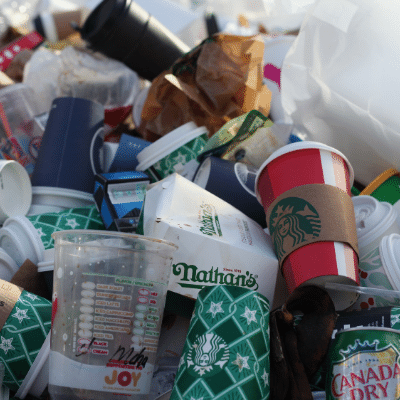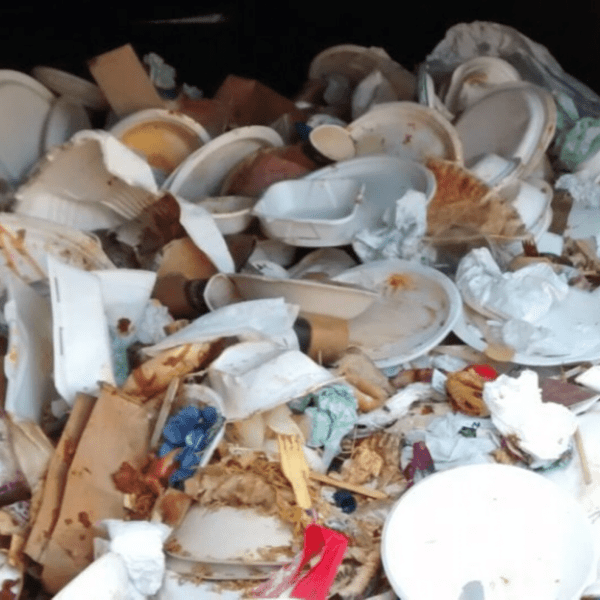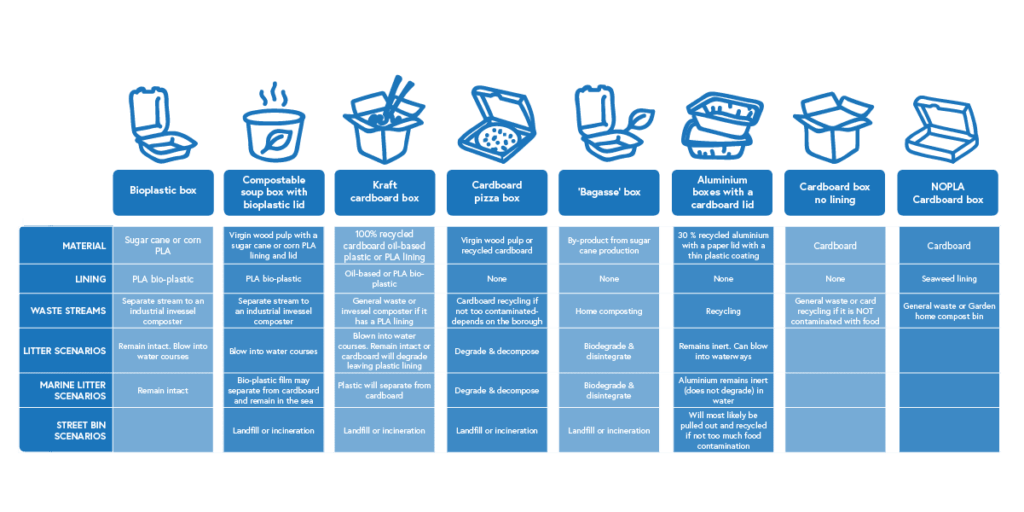Takeaway packaging guidance
Takeaway Packaging – what’s the most sustainable option?
Over the last 18 months, we’ve seen a huge increase in the number of enquiries from the businesses we work with, the media and also the public – all wanting to find out more about single-use packaging and what the most sustainable options are.With so many packaging types on the market, navigating terms like compostable, biodegradable and eco-friendly can be a minefield. Which is the most sustainable? And does compostable really mean compostable?!
As an organisation, we would always advocate reuse over single-use and believe we need to transition from our current disposable culture to one that values its resources and understands the impact of our choices. Whereever possible we would encourage organisations to consider the waste hierarchy and the need to reduce before all else. At City to Sea, we are concerned with stemming the flow of plastic pollution – from city to sea. This means we have to consider whether a product contributes to marine pollution in addition to other environmental impacts. Read on for some reality checks when it comes to take-away packaging and a full breakdown of the options….
Reality checks for takeaway packaging
Regardless of the claims that are made about different types of disposable packaging, unfortunately, the reality of what happens when they are used is quite different!
- The go-to bin on most high streets and beach fronts is a general waste bin, and the contents are generally sent for incineration (yes, burned!).
- Compostable food packaging can’t be thrown into a bin on any high street or beachfront. Compostable packaging requires a special arrangement to be collected separately from any other rubbish. Find out more about compostable takeaway packaging.
- Any packaging (plastic, card or aluminium) that ends up in the recycling that has food on it is treated as contaminated, and therefore can’t actually be recycled.
With these complexities, it’s clear to see why we advocate reduce and reuse where ever possible.

Food for thought
If you still need to use single-use, disposable materials due to your ordering system or other factors, be sure to consider these things:
- Where are your customers consuming your food and putting their takeaway containers after they have used them??
- If most of your takeaways are going to your customers home, think about what recycling facilities they will have available to them.
- Or, if they are going to be consumed close by, what’s on offer in your local public spaces? If your takeaways are likely to be eaten at the beach or in the local park, could they become litter because of overflowing general waste bins?
In our Disposables and Reusables guide, we look at different types of disposable packaging and consider its outcome in different locations and recycling or waste systems. Take a look and see how your current packaging choice compares.
TAKE-AWAY PACKING: A COMPARISON OF THE OPTIONS
We want to help make it as easy as possible for you to navigate the many packaging options available and reduce waste. We’ve created a detailed comparison of the options available including information on reusable, compostable and bioplastic packaging and advice on reducing single-use.
The most sustainable disposable options

Food eaten at home
Cardboard packaging.
This usually has a thin plastic lining but can still be washed out and put in cardboard recycling, as long as it’s clean and free from grease marks – check out WRAP’s guidance on cardboard packaging for packaging that can be recycled.
Remember, whatever packaging you use, food and grease contaminates all recycling (aluminium, plastic, glass, paper). Make sure to label packaging clearly to encourage consumers to clean it before putting in the recycling bin.

Food eaten on the go
Bagasse.
These soft paper-style boxes are not lined with any plastic or other material and will decompose naturally if they end up becoming litter. Bagasse is slightly absorbent but does not leak sauces. This can also go in home compost bins (but not food caddies – see explanation on bioplastics below).
The reality is that in areas like parks and beaches there are usually only general waste bins which quickly overflow. All the waste in these bins will generally end up going for waste-to-energy incineration. So the focus should be on what happens if your item becomes litter.
Choose to reuse

The sustainable solution
We’ve always said that the most sustainable solution is reuse over single-use. And now 125 scientists have confirmed that single-use plastics are no safer than any other material and reusable containers are safe to use provided they are cleaned properly.
Working with our partners and some members of REPEAT (Our Reuse Action Taskforce) we’ve put together guidance for keeping reusables on the menu. So whether it’s water, coffee or takeaway food we’ve got you covered.

OUR TOP TIPS FOR REDUCING SINGLE-USE PLASTIC
We’ve teamed up with our friends at Greenpeace to create some super simple guidance to help you get started when it comes to reducing single-use plastic and returning to reuse.
Check out our top tips here or read on for everything you need to know to unpack packaging.
What about compostable bioplastics?
Whilst they might sound like the solution to plastic pollution, we have extensively researched compostable bioplastics and that is not the case. Most compostable bioplastics are actually pretty rubbish!

THE TRUTH ABOUT ‘COMPOSTABLE’ BIOPLASTICS
- They won’t compost or biodegrade if they become litter or marine litter as they need temperatures of 60 degrees plus – which obviously is not found in our parks, rivers or seas!
- They aren’t accepted in most household food recycling (the food caddy that gets collected) because the plants that process food can only process food and can’t tell a bioplastic from a petro-chemical plastic. It’s all just plastic to them! The conditions aren’t right for these bioplastics to compost either. To get your head around this, check out our guide to bioplastics.
- If compostable materials end do up in a general waste bin, they will end up going to waste-to-energy incineration (this is where most general waste goes) so they will not compost at all.

- The reality is that to actually get these materials composted, you’d need to find a recycling plant that will accept them.
- Vegware has found some composting plants in the UK that will take their packaging. But this is only available in 39% of UK postcodes and only for Vegware packaging. Any other brand of compostable packaging would need approval from a plant before they accept it because different packaging breaks down at different times.
Even if you do find a way to correctly dispose of compostable bioplastics, you will need to pay for this service and ask your customer to bring their takeaway packaging back to you. Which means they need to carry it around until their next visit. So they may as well carry a reusable that they can easily wash up at home! Clearly compostable bioplastics are not a simple solution to the single-use plastic problem.
For more advice on opening back sustainably check out the Sustainable Restaurant Association guidance.
QUICK CHECK: WHAT ARE THE RECOMMENDATIONS?
Here’s a quick check of each item – our recommendations in terms of sustainability and what the current government guidance is. For a more detailed comparison of each item read the takeaway-packaging comparison guide here.
| Item | Law/ Govt guidance | Eat-in best practice | Takeaway |
| Sauces |
Whilst the government has provided some guidance on this, in that you can’t use multi-serve pumps for customers. But you can use reusable bottles/containers providing they are cleaned after each use. |
Put sauces in reusable containers and wash them after each use. |
Make sachets request only. OR, put sauces in paper pots in the food box if requested. |
| Cutlery |
No specifications for reusables when serving in-house. Reusables are safe to use. EU and all devolved nations will be phasing single-use plastic cutlery tout in July 2021 as part of the SUP directive. |
Lay the table with reusable cutlery.
Bring it to the table for the customer. |
Ask customers if they need cutlery before automatically putting them in a bag. Opt for wooden cutlery if you need to give single-use out. Make sure it’s FSC certified. |
| Plates |
No specifications for using reusables or disposables. Advice to wash hands after handling items. |
Serve on reusable plates. | Choose a material without a plastic or bioplastic liner e.g. bagasse, no-PLA or a recycled cardboard box |
| Hot drink cups |
No specifications for using reusables or disposables. |
Use china and reusable options where possible. | Accept customers own cups using the Contactless coffee methodology. |
| Napkins | Ask customers if they need them | ||
| Glasses/cups |
No specifications for using reusables or disposables. Follow basic health and safety guidance. |
Default to reusable pint glasses/glasses. Reusable plastic options are available and can be washed in the same way after use. |
Accept customers reusable pint glasses/cups using the contactless method (this, unfortunately, doesn’t work for pints) Introduce a deposit scheme for reusable glasses. |
Item: Sauces
Law/Govt guidance: Whilst the government has provided some guidance on this, in that you can’t use multi-serve pumps for customers. But you can use reusable bottles/containers providing they are cleaned after each use.
Eat-in best practice: Put sauces in reusable containers and wash them after each use.
Takeaway: Make sachets request only. OR, put sauces in paper pots in the food box if requested.
Item: Cutlery
Law/Govt guidance: No specifications for reusables when serving in-house. Reusables are safe to use. EU and all devolved nations will be phasing single-use plastic cutlery tout in July 2021 as part of the SUP directive.
Eat-in best practice: Lay the table with reusable cutlery. Bring it to the table for the customer.
Takeaway: Ask customers if they need cutlery before automatically putting them in a bag. Opt for wooden cutlery if you need to give single-use out. Make sure it’s FSC certified.
Item: Plates
Law/Govt guidance: No specifications for using reusables or disposables. Advice to wash hands after handling items.
Eat-in best practice: Serve on reusable plates.
Takeaway: Choose a material without a plastic or bioplastic liner e.g. bagasse, no-PLA or a recycled cardboard box.
Item: Hot drink cups
Law/Govt guidance: No specifications for using reusables or disposables. Advice to wash hands after handling items and find a way to minimise contact e.g. use a tray and follow the contactless coffee method.
Eat-in best practice: Use china and reusable options where possible.
Takeaway: Accept customers own cups using the Contactless coffee methodology.
Item: Napkins
Takeaway: Ask customers if they need them.
Item: Glasses/cups
Law/Govt guidance: No specifications for using reusables or disposables. Follow basic health and safety guidance.
Eat-in best practice: Default to reusable pint glasses/glasses. Reusable plastic options are available and can be washed in the same way after use.
Takeaway: Accept customers reusable pint glasses/cups using the contactless method (this, unfortunately, doesn’t work for pints). Introduce a deposit scheme for reusable glasses.
Here are some other useful resources:
- https://www.food.gov.uk/business-guidance/adapting-restaurants-and-food-delivery-during-covid-19#food-safety
- https://www.gov.uk/government/publications/covid-19-guidance-for-food-businesses/guidance-for-food-businesses-on-coronavirus-covid-19
- https://www.food.gov.uk/sites/default/files/media/document/reopening-checklist-for-food-businesses-during-covid-19-form.pdf
- https://www.gov.uk/guidance/working-safely-during-coronavirus-covid-19/restaurants-offering-takeaway-or-delivery#takeaways-2-3
JOIN THE REFILL REVOLUTION
If you’re already accepting reusable containers, cups or offering free drinking water for your customers then make sure you’re signed up to the Refill campaign here.
- 85% of people would view businesses that offered Refills for food and drink a lot more positively.
- With over 350,000 app users signing up is a great way to drive footfall to your business.
- On average, someone who pops in to get a free drinking water refill will spend between £2.50 and £5 in store.


